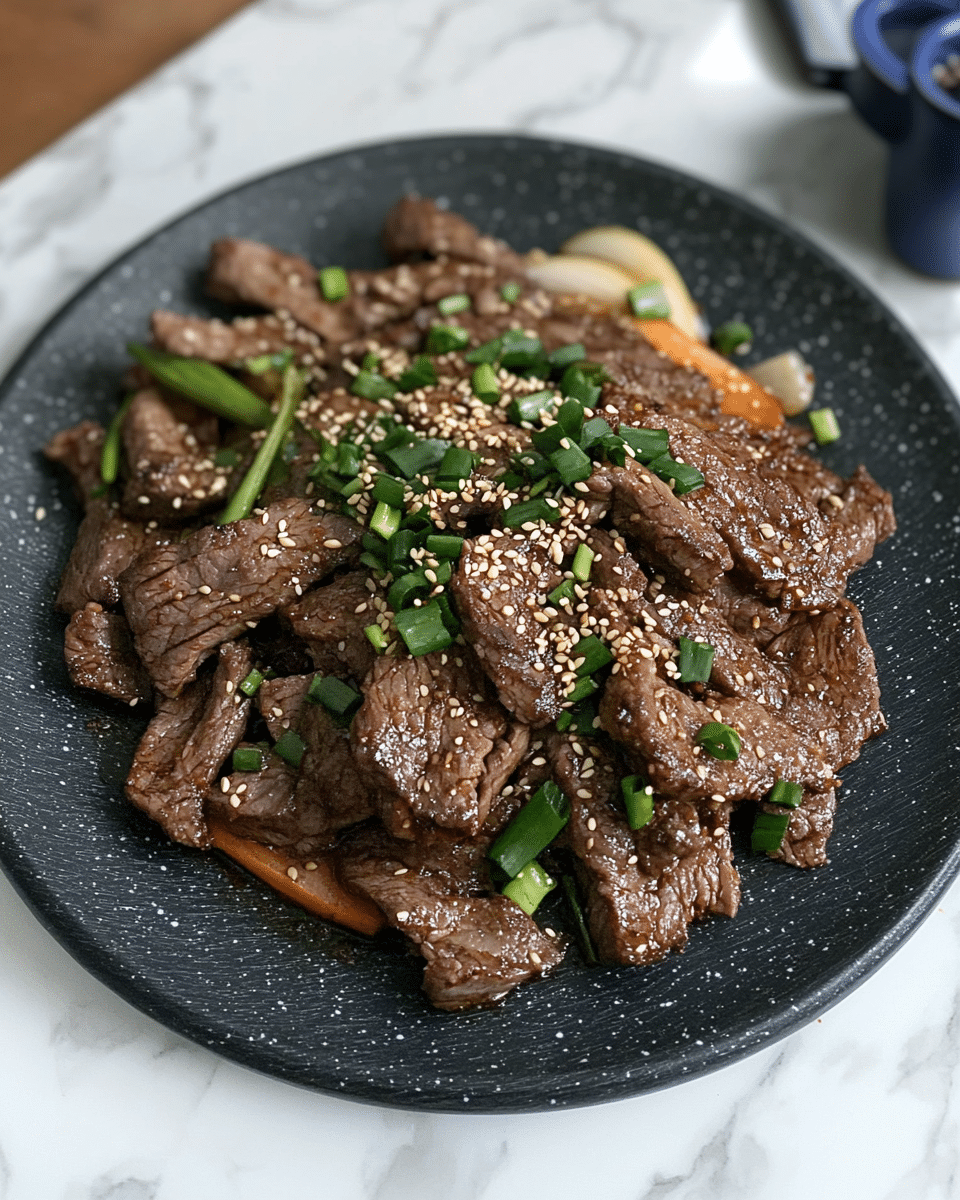Black Stone Korean BBQ Beef Bulgogi is a flavorful and tender marinated beef dish, cooked quickly on a hot grill or skillet. This classic Korean recipe features thinly sliced beef infused with a sweet and savory sauce, perfect for a delicious and satisfying dinner.
FULL RECIPE
Ingredients
- 1 lb (450 g) thinly sliced beef ribeye or sirloin
- 1/4 cup soy sauce
- 2 tablespoons sugar
- 1 tablespoon sesame oil
- 3 cloves garlic, minced
- 1 teaspoon ginger, grated
- 1/4 cup chopped green onions
- 1 tablespoon rice wine or mirin
- 1/2 teaspoon black pepper
- 1 tablespoon toasted sesame seeds
- 1 small onion, thinly sliced
- Optional: 1/2 grated pear or apple for extra tenderness
Directions
- In a bowl, combine soy sauce, sugar, sesame oil, garlic, ginger, green onions, rice wine, black pepper, and toasted sesame seeds to make the marinade.
- Add the thinly sliced beef and sliced onion to the marinade, mixing well to coat evenly. Optionally, add grated pear or apple for tenderness.
- Cover and refrigerate for at least 30 minutes, preferably 1-2 hours for deeper flavor.
- Heat a grill pan or skillet over medium-high heat.
- Cook the marinated beef in batches, spreading it evenly on the hot surface. Cook for 2-3 minutes per side until beef is cooked through and slightly caramelized.
- Serve hot with steamed rice and side dishes such as kimchi or lettuce wraps.
Nutritional Information (per serving, approx.)
- Calories: 320 kcal
- Protein: 28 g
- Fat: 18 g
- Carbohydrates: 10 g
- Sugars: 8 g
- Sodium: 800 mg
History and Cultural Significance of Bulgogi
Bulgogi, which literally means “fire meat” in Korean, has a rich history that dates back centuries. Originally, it was a dish enjoyed by Korean royalty and nobility due to the use of high-quality beef and elaborate preparation methods. Over time, bulgogi became more accessible to the general population and evolved into one of Korea’s most beloved and iconic dishes. The method of marinating thinly sliced beef with a combination of soy sauce, sugar, garlic, and sesame oil creates a unique flavor profile that balances sweet, savory, and umami notes. Bulgogi is often prepared during special occasions and family gatherings, serving as both a communal dish and a symbol of Korean hospitality and warmth.
Flavor Profile and Ingredients Insight
The magic of bulgogi lies in its marinade, which transforms simple beef into an aromatic and tender delight. The balance between sweetness and saltiness comes from the careful use of soy sauce and sugar, which caramelize during cooking, creating a beautiful glaze on the meat. Garlic and ginger add pungency and warmth, while sesame oil imparts a nutty richness that enhances the overall depth of flavor. The addition of green onions brings a fresh, slightly sharp contrast, and the toasted sesame seeds provide a subtle crunch and toasty aroma. Many traditional recipes include grated pear or apple to naturally tenderize the meat while adding a subtle fruity sweetness. This combination of ingredients highlights Korean cuisine’s emphasis on harmony and layering of flavors.
Cooking Techniques and Serving Suggestions
The traditional way to prepare bulgogi is grilling over an open flame, which adds a smoky char to the tender meat. However, modern adaptations often use a grill pan or skillet for convenience, especially for home cooks. The high heat cooking method ensures quick caramelization while keeping the beef juicy and tender. Bulgogi is usually sliced very thin to allow the marinade to penetrate fully and to enable fast cooking. This also helps maintain a tender texture that melts in your mouth. Serving bulgogi typically involves rice as a neutral base, which balances the richness of the meat. It is also commonly paired with various banchan — Korean side dishes such as kimchi, pickled vegetables, and seasoned greens — which add contrasting flavors and textures. Lettuce or perilla leaves are often provided to make wraps (ssam), combining the savory beef with fresh, crisp greens, garlic slices, and spicy sauces for a complete and interactive dining experience.
Nutritional Considerations and Variations
Bulgogi can be considered a well-rounded meal with a good balance of protein, fats, and carbohydrates, especially when paired with rice and vegetables. The beef provides a rich source of protein and essential nutrients such as iron and zinc, which support muscle function and immune health. The marinade’s sugar content adds calories but is crucial for the characteristic sweet flavor and caramelization. For those monitoring sodium intake, the soy sauce component can be adjusted or replaced with low-sodium alternatives. Bulgogi recipes can also be adapted for different dietary needs, including using leaner cuts of beef or substituting with pork or chicken. Vegetarian versions use mushrooms or tofu, marinated similarly, to capture the dish’s essence without meat. This flexibility has helped bulgogi maintain popularity both in Korea and internationally.
Popularity and Influence Outside Korea
In recent decades, bulgogi has become one of the most recognizable Korean dishes worldwide, thanks in part to the global rise of Korean culture, including K-pop and Korean dramas. Korean BBQ restaurants are now common in many cities globally, with bulgogi often being a highlight on menus. Its approachable flavors and versatile serving options make it appealing to a wide range of palates. Moreover, bulgogi’s influence extends into fusion cuisines, where chefs experiment by incorporating it into tacos, burgers, and sandwiches, blending Korean flavors with local culinary traditions. This adaptability showcases the dish’s broad appeal and the growing interest in Korean gastronomy on the world stage.
Tips for Making the Best Bulgogi at Home
Achieving restaurant-quality bulgogi at home involves attention to a few key details. First, selecting the right cut of beef is essential; ribeye and sirloin are preferred for their tenderness and marbling, which help keep the meat juicy during cooking. Slicing the beef very thinly against the grain ensures tenderness and helps the marinade penetrate more deeply. Marinating time is also important — while a short 30-minute soak can work in a pinch, allowing the meat to rest in the marinade for a few hours or overnight will yield more intense flavor and better texture. Cooking over high heat with minimal stirring helps develop that desirable caramelized crust. Additionally, serving bulgogi with fresh, crisp accompaniments like leafy greens, garlic, and chili paste can elevate the meal experience. Experimenting with small tweaks in the marinade, such as adding a touch of honey or chili flakes, can personalize the dish to your taste preferences.
Conclusion
Black Stone Korean BBQ Beef Bulgogi is far more than just a marinated beef dish; it is a culinary tradition steeped in history, culture, and social connection. Its perfect blend of sweet, savory, and aromatic flavors, combined with tender, quick-cooked beef, makes it a versatile and beloved staple in Korean cuisine. Whether enjoyed in a traditional Korean setting or adapted for modern fusion dishes, bulgogi continues to capture hearts and palates around the world. By understanding its roots, flavor complexity, and cooking techniques, home cooks can confidently prepare bulgogi that honors its heritage while bringing rich, authentic taste to their table.








